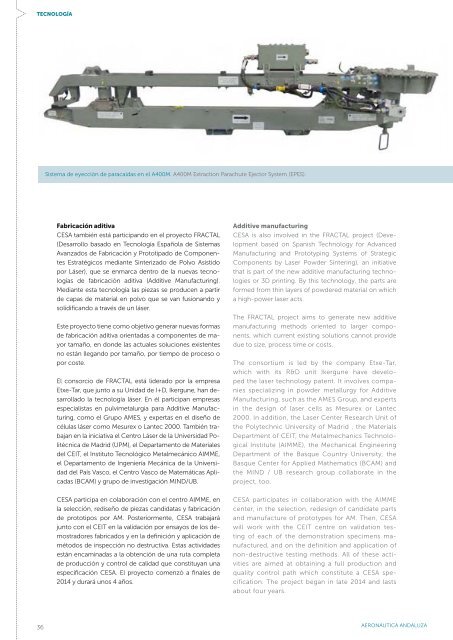AERONET LA RESPUESTA TECNOLÓGICA A LA CADENA DE SUMINISTRO
aa_38_72
aa_38_72
Create successful ePaper yourself
Turn your PDF publications into a flip-book with our unique Google optimized e-Paper software.
TECNOLOGÍA<br />
Sistema de eyección de paracaídas en el A400M. A400M Extraction Parachute Ejector System (EPES).<br />
Fabricación aditiva<br />
CESA también está participando en el proyecto FRACTAL<br />
(Desarrollo basado en Tecnología Española de Sistemas<br />
Avanzados de Fabricación y Prototipado de Componentes<br />
Estratégicos mediante Sinterizado de Polvo Asistido<br />
por Láser), que se enmarca dentro de la nuevas tecnologías<br />
de fabricación aditiva (Additive Manufacturing).<br />
Mediante esta tecnología las piezas se producen a partir<br />
de capas de material en polvo que se van fusionando y<br />
solidificando a través de un láser.<br />
Este proyecto tiene como objetivo generar nuevas formas<br />
de fabricación aditiva orientadas a componentes de mayor<br />
tamaño, en donde las actuales soluciones existentes<br />
no están llegando por tamaño, por tiempo de proceso o<br />
por coste.<br />
El consorcio de FRACTAL está liderado por la empresa<br />
Etxe-Tar, que junto a su Unidad de I+D, Ikergune, han desarrollado<br />
la tecnología láser. En él participan empresas<br />
especialistas en pulvimetalurgia para Additive Manufacturing,<br />
como el Grupo AMES, y expertas en el diseño de<br />
células láser como Mesurex o Lantec 2000. También trabajan<br />
en la iniciativa el Centro Láser de la Universidad Politécnica<br />
de Madrid (UPM), el Departamento de Materiales<br />
del CEIT, el Instituto Tecnológico Metalmecánico AIMME,<br />
el Departamento de Ingeniería Mecánica de la Universidad<br />
del País Vasco, el Centro Vasco de Matemáticas Aplicadas<br />
(BCAM) y grupo de investigación MIND/UB.<br />
CESA participa en colaboración con el centro AIMME, en<br />
la selección, rediseño de piezas candidatas y fabricación<br />
de prototipos por AM. Posteriormente, CESA trabajará<br />
junto con el CEIT en la validación por ensayos de los demostradores<br />
fabricados y en la definición y aplicación de<br />
métodos de inspección no destructiva. Estas actividades<br />
están encaminadas a la obtención de una ruta completa<br />
de producción y control de calidad que constituyan una<br />
especificación CESA. El proyecto comenzó a finales de<br />
2014 y durará unos 4 años.<br />
Additive manufacturing<br />
CESA is also involved in the FRACTAL project (Development<br />
based on Spanish Technology for Advanced<br />
Manufacturing and Prototyping Systems of Strategic<br />
Components by Laser Powder Sintering), an initiative<br />
that is part of the new additive manufacturing technologies<br />
or 3D printing. By this technology, the parts are<br />
formed from thin layers of powdered material on which<br />
a high-power laser acts.<br />
The FRACTAL project aims to generate new additive<br />
manufacturing methods oriented to larger components,<br />
which current existing solutions cannot provide<br />
due to size, process time or costs.<br />
The consortium is led by the company Etxe-Tar,<br />
which with its R&D unit Ikergune have developed<br />
the laser technology patent. It involves companies<br />
specializing in powder metallurgy for Additive<br />
Manufacturing, such as the AMES Group, and experts<br />
in the design of laser cells as Mesurex or Lantec<br />
2000. In addition, the Laser Center Research Unit of<br />
the Polytechnic University of Madrid , the Materials<br />
Department of CEIT, the Metalmechanics Technological<br />
Institute (AIMME), the Mechanical Engineering<br />
Department of the Basque Country University, the<br />
Basque Center for Applied Mathematics (BCAM) and<br />
the MIND / UB research group collaborate in the<br />
project, too.<br />
CESA participates in collaboration with the AIMME<br />
center, in the selection, redesign of candidate parts<br />
and manufacture of prototypes for AM. Then, CESA<br />
will work with the CEIT centre on validation testing<br />
of each of the demonstration specimens manufactured,<br />
and on the definition and application of<br />
non-destructive testing methods. All of these activities<br />
are aimed at obtaining a full production and<br />
quality control path which constitute a CESA specification.<br />
The project began in late 2014 and lasts<br />
about four years.<br />
36<br />
AERONÁUTICA ANDALUZA


